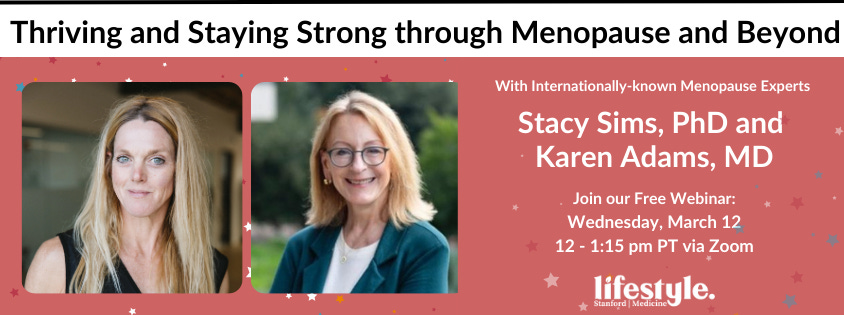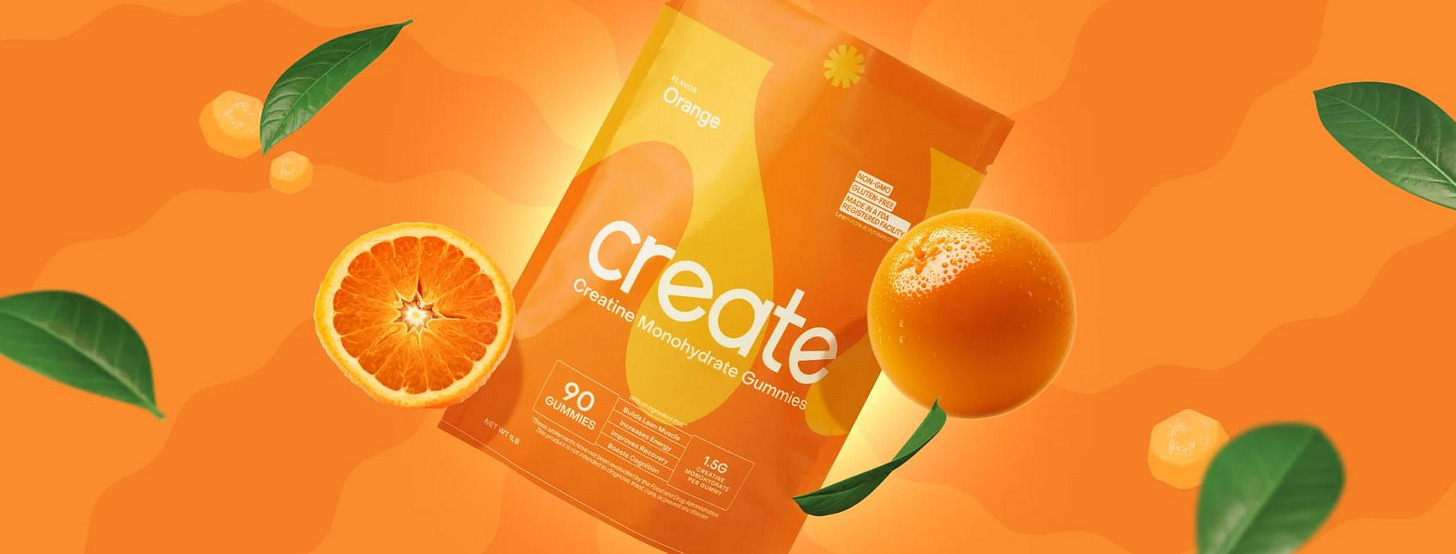Monthly Mythbust: Should you sync strength training to your menstrual cycle?
Here's what the science says.
Happy International Women’s Day!
My month is shaping up to be all about women’s health: I was featured in the latest Stanford Lifestyle Medicine Newsletter in an article on supplements for women ages 40+ and I will be co-hosting a webinar on menopause March 12 (read on for links). In addition, in the sports nutrition class I’m teaching at Stanford this week, we’re talking about unique needs of female athletes, which got me thinking about all the hype around women’s health and training. So, I felt it would be timely to cover the much-discussed topic of “cycle syncing” with my Substack community.
First, an alarming fact - only about 6% of performance research is done on females, which leaves a huge gap in knowledge – a vacuum that wellness influencers are only too happy to fill. But I feel like I can help you BS by focusing on an area where I have decades of expertise – muscle, strength training, and women.
There’s a lot of chatter online about how the menstrual cycle impacts strength training and muscle growth.
Some claim you should time your workouts around hormonal fluctuations to optimize gains, while others suggest that certain phases make building muscle harder.
Some say there are “ideal” times to lift heavy and other times when you should take it easy. But here’s the real deal: your cycle does not make or break your gains. Your body can build muscle no matter what time of the month it is.
Let’s break it down and bust this myth once and for all.
The four phases of the menstrual cycle:
The menstrual cycle has four phases, each with its own hormonal shifts.
The menstrual phase (around days 1-5) kicks things off with your period, when estrogen and progesterone are at their lowest. You might feel a little more sluggish, OR you might feel totally fine—everyone’s different! Fun fact: Paula Radcliffe broke the world record for the marathon in her menstrual phase and held that record for 16 years.
The follicular phase (days 6-14) follows, bringing a rise in estrogen, which some people say gives them an energy boost.
Then comes ovulation (around day 14), when estrogen peaks. Some claim this is the ultimate time for hitting PRs, but spoiler: science doesn’t actually back that up.
Finally, the luteal phase (days 15-28) rolls in, with progesterone on the rise and estrogen dipping. This is when bloating, fatigue, and general blah-ness might hit—but does it mean you can’t build muscle? Nope.
And here’s the thing, this outline of phases is what we would consider “ideal” or “typical.” BUT, in reality, they are VERY different person to person, not to mention month to month in the same person. So, they’re super tricky to track and time.
And while it may sound intriguing that hormonal shifts could affect performance and muscle response, the science continues to say the opposite.
A recent study in The Journal of Physiology found zero difference in muscle-building capacity across different phases of the menstrual cycle. Whether estrogen is high or low, your muscles don’t really care.
A large review of all the science from the University of North Carolina compared training based on hormone phases versus training based on how people felt. The result? No difference in strength gains. What did matter was consistency – and adjusting workouts based on energy levels, not some arbitrary hormone chart.
Another recent meta-analysis of 22 studies found that while there may be small variations in isometric, dynamic, or isokinetic output during different menstrual phases, there are no significant strength differences long term.
Cycle syncing could mess with your mental game.
Here’s how I see it: not only is cycle syncing unnecessary, but it could actually mess with your mental game, especially if you're an athlete or have to perform on a schedule.
If you start believing you can only hit big lifts or peak performances during certain phases of your cycle, what happens when competition day lands in your luteal phase? Or when you have an important race during your period? Relying too much on cycle syncing can create unnecessary mental barriers, making you doubt your abilities simply because the timing isn’t “perfect.” Instead of overanalyzing hormones, the science says training should focus on adaptability, confidence, and consistency.
Not only that, but I personally find it pretty insulting that people would assume that a female body is “weak” or “less than” because we menstruate. Like, “f*ck off” that I can’t hit a big lift in my luteal phase because of my hormones. It harkens to “women can’t lead because they are too emotional.” I know women want to know more about our bodies, our menstrual cycles, and what is truly happening during hormonal shifts. But the science is showing that cycle syncing ain’t it.
So, what does this mean for you?
It means you don’t need to stress about timing your training to your cycle. If you feel amazing, go ahead and lift heavy. If you’re feeling off, scale back a bit— but that’s just smart training in general, not because of your hormones. Strength comes from showing up, challenging yourself, and recovering well —not from syncing your workouts to your estrogen levels.
The takeaway? Ditch the overcomplicated synching protocols and just focus on getting stronger, no matter what time of the month it is.
If you want to learn more about how to build an exercise plan, check out this article I wrote: Simple Strength Training Routines for all Fitness Levels.
Free Stanford Lifestyle Medicine Menopause Webinar: Join me March 12!
I’d like to invite you to a free LIVE webinar I’m co-hosting for the Stanford Lifestyle Medicine Access to Experts Webinar Series. “Thriving and Staying Strong through Menopause and Beyond” takes place Wednesday, March 12, from 12 to 1:15 PT via Zoom.
Bring your questions about perimenopause and menopause for this Q&A session featuring two women’s health and menopause experts:
Stacy Sims, PhD, exercise physiologist and nutrition scientist.
Karen Adams, MD, OB-GYN, director of Stanford’s Menopause & Healthy Aging program.
I will serve as a moderator, along with my colleague Anne Friedlander, PhD, Assistant Director of Stanford Lifestyle Medicine and Adjunct Professor of Human Biology.
Get 20% off your first Create Creatine order
I don’t endorse many products, but I’m a huge fan of creatine, especially for women’s health. Create Wellness products are NSF certified and third-party tested to ensure the highest quality and efficacy. I’ve been enjoying the benefits of Create’s creatine gummies for a year now, and they’re among my very favorites.
Shop my recommendations and get 20% off your first order at Create Wellness!
Click this link or the button below: https://trycreate.co/RACHELEPOJEDNIC
Check it out:
Come see me when I present, “Game, Set, Recover” on behalf of Restore Hyper Wellness at RacquetX March 22-24, 2025, at the Miami Beach Convention Center. I’m psyched to be presenting with Rachelle Reed, Head of Scientific Research at Therabody. Learn more and register here.
Midlife marks a significant life transition, bringing hormonal shifts that can reshape a woman’s body and wellbeing. Read my top supplement recommendations for women 40+ in the March Stanford Lifestyle Medicine newsletter.
If you want to learn more about my Sports Nutrition Class (HUMBIO132) at Stanford, check out a recent write up “Beyond the Buzzwords: Sports Nutrition’s Take on Evidence-Based Nutrition” in the Stanford Program in Human Biology newsletter.
Do you need a speaker at your workplace? Book me to lead your next worksite virtual wellness event, where you and your colleagues can learn healthy nutrition tips to fuel and optimize your workday.
Have you checked out my accredited courses on my Strong Process Education platform? Learn about my nutrition, physical activity and behavior change courses designed for health coaches, fitness professionals, and wellness enthusiasts.
Upgrade to a paid subscription to receive every post and added benefits — including bonus content, voiceovers of articles and the ability to post comments. Plus, stay tuned for a series of live webinars and more.
For insights, ideas, and tips, follow me online and share with your friends:
Keep reading with a 7-day free trial
Subscribe to Strong Process to keep reading this post and get 7 days of free access to the full post archives.






